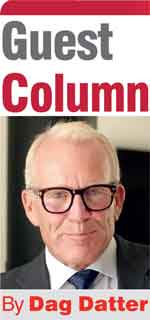Wednesday Dec 31, 2025
Wednesday Dec 31, 2025
Thursday, 27 July 2023 00:00 - - {{hitsCtrl.values.hits}}

 Things are more expensive in Sri Lanka than ever. Families spend most of their household income on food alone. Prices of food, clothing and housing are continuing to rise. In addition, electricity bills have soared, income tax has increased, and subsidies on everything from food to household bills have been removed.
Things are more expensive in Sri Lanka than ever. Families spend most of their household income on food alone. Prices of food, clothing and housing are continuing to rise. In addition, electricity bills have soared, income tax has increased, and subsidies on everything from food to household bills have been removed.
The country still has over $ 80 billion of public debt, of which almost half is to foreign bondholders, including the largest share owed to China. However, it is the restructuring of domestic debt that is likely to have a much bigger impact on the Sri Lankan people, including potentially cutting workers’ pensions.
The Sri Lankan Government has largely ignored the question of how the other side of the balance sheet – public assets – can help to alleviate the problem. In reality it is sitting on a hidden gold mine of public commercial assets, a portfolio comprising real estate and operational assets. A portfolio that better describes an iceberg where we only see the tip of all the wealth with a total value that is most likely significantly higher than the outstanding public debt. The correct value is seldom known, as the assets are often badly managed and not properly accounted for in the Government’s financial statements.
The portfolio plays a fundamental role in the economy because it operates in important sectors on which the broader economy depends. This is why the importance of well-governed public commercial assets cannot be overstated.
Publicly owned real estate alone in Sri Lanka will be worth at least $ 90 billion, more than the outstanding public debt. On top of this is the value of the operational assets active within key sectors such as energy (electricity and petroleum), water, transportation (ports, airlines), construction, and not the least, banking and finance, as well as insurance. Many of these are currently loss-making and therefore add to the financial burden of the Government. With the local banks funding many of these loss-making Government-owned corporations instead of supporting productive private sector companies, it leads to a misallocation of valuable capital, crowding out of the private sector initiatives and ultimately increased vulnerability for the local banking sector.
Professionally managed, all public assets could generate an additional $ 30 billion annually in revenues for the Government, according to IMF research. This income could be used to pay for investments in infrastructure and other public services. Properly structured improvements in public wealth management could also help to win the war against corruption by introducing private sector disciplines, including transparency, commercial objectives, and political insulation through an independent corporate holding company – a Public Wealth Fund (PWF).
Technically this is relatively easy and is done in the private sector daily. It is mainly a political challenge. The key to unlocking public wealth lies in the separation of governance of public commercial assets from policymaking. As demonstrated by a century of experimenting with public asset management in Asia and Europe.
Separating the regulatory function within a government from that of ownership clearly and transparently would thus enhance the likelihood of increased private sector investments and foreign direct investments, as well as improved services towards the consumers.
Most governments worldwide have delegated the management of many other core public financial operations to separate professional institutions. For example, the management of government debt is outsourced to a debt management office, while the responsibility for setting interest rates is assigned to a central bank. Authority is delegated to professionals for the very reason that they are expected to be politically independent, neutral, and can be easily held accountable against narrowly defined targets.
Professional management of public commercial assets remains one of the final challenges for more effective public financial management. This would require an independent PWF that would introduce all the relevant private sector disciplines and conduct its business with full transparency, echoing the procedures of listed companies. As in the private sector, it would come with internationally accepted corporate governance and accounting standards. All implicit opportunity costs should be visible in budget reviews to the various public services and government departments using these assets.
A fully integrated inventory of public assets should then be established and maintained, where the market value of each assessed asset takes into account its potential for alternative uses so as to maximise potential yields. This would force managers to design and develop comprehensive business plans for all assets, putting each asset to its most productive use while making visible the cost of using the asset in any suboptimal way.
An efficiently managed PWF would cut the drain on the Government’s budget and resources, increase the value of public commercial assets, provide revenues and would be a major contributor to fiscal sustainability. More efficiently managed assets would contribute to a higher rate of real GDP growth and lower private sector operating costs. If properly administered, the move would bolster faith in Sri Lanka’s credit rating assessment, lowering the cost of borrowing on the international market and thus benefiting society as a whole.
Every penny generated with an increase in yield from public commercial assets is a penny less from budgetary cuts or increases in taxation.
(The writer is the principal of Detter & Co, an advisor to governments, investors and IFIs such as the IMF, World Bank and The Asian Development Bank. He led the restructuring of the Swedish portfolio of state-owned assets and is the author of the Public Wealth of Nations – the Financial Times and The Economist ‘Best Book of the Year’ 2015 and the forthcoming ‘Public Net Worth – Accounting, Government and Democracy’.)